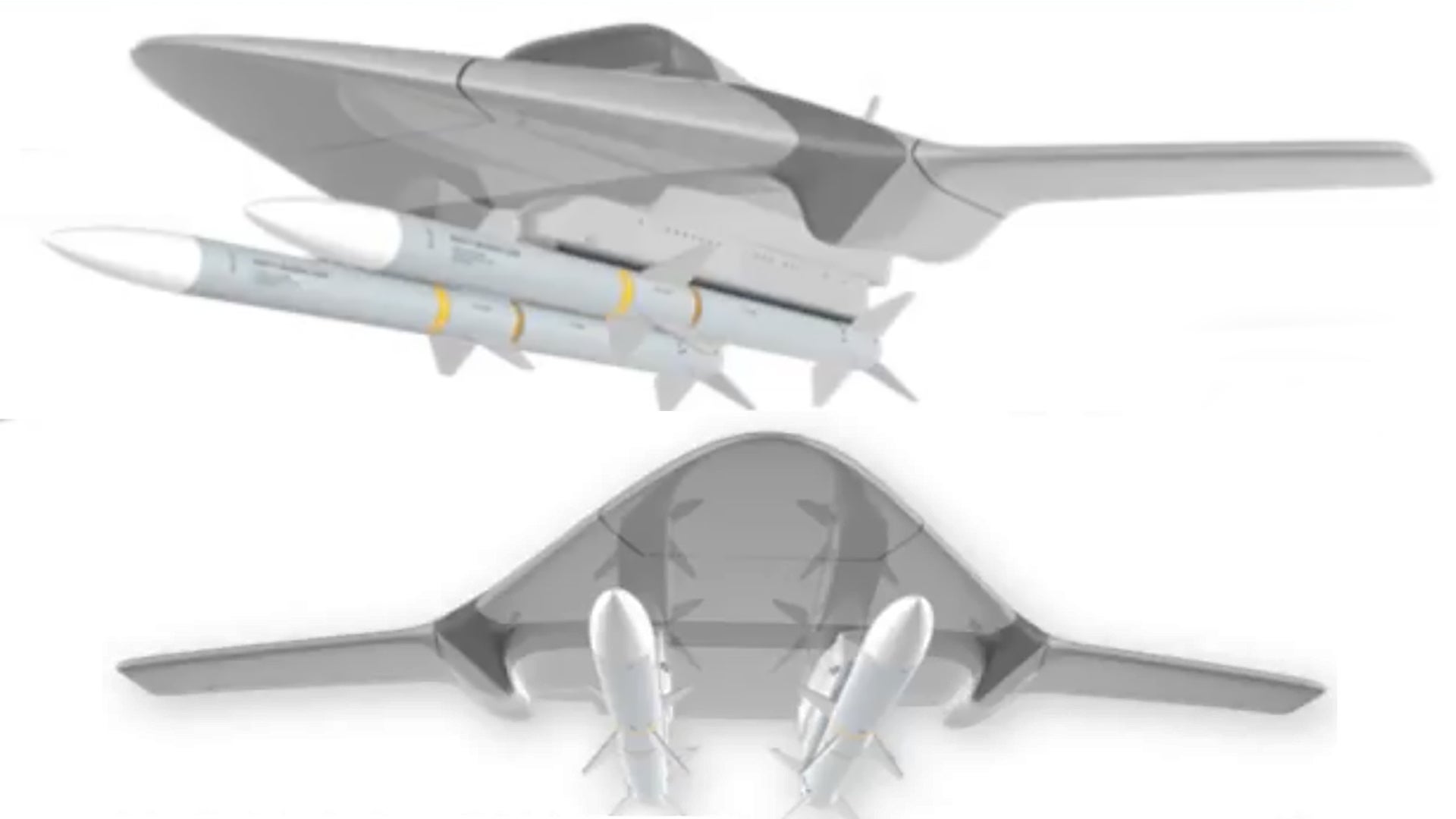The Defense Advanced Research Projects Agency (DARPA) has published its plan for a rapidly manufactured “Flying Missile Rail” drone that can be launched off the wing of a tactical jet. The concept sounds strange, and to some degree it is, but its existence could help underline the fact that unmanned systems can break the current bloated and slow tactical aircraft procurement model that is failing under its own weight. It also speaks to some larger concepts and questions as to the Pentagon’s grand unmanned strategy—or lack thereof.
The Flying Missile Rail concept is explained in a pitch reel of sorts from DARPA presented by USAF Lieutenant Colonel Jimmy Jones of the Strategic Technologies Office, a unit that seems to be focused on the Pentagon’s shadowy third offset strategy initiative. The group is officially described as “seeking applications to develop disruptive technologies that will improve systems and capabilities.”
Strangely enough, the renderings of the Flying Missile Rail concept look very similar to a certain model that was spotted on a Northrop Grumman executive’s credenza recently. It is unclear if there is some relation or if it is just a fluke.
The idea behind the concept is really two fold. First off it has to do with creating a low-end “attritable” unmanned system that has a single purpose—to launch an AIM-120 air-to-air missile either while still attached to a host aircraft or by being launched from that host aircraft and flying for 20 minutes along a series of waypoints and launching the missile on command from a remote location. If the system is launched from an aircraft or if it fires a missile it would not be reusable. If it can hold and fire more than one AIM-120 missile that is a plus, but not a requirement.
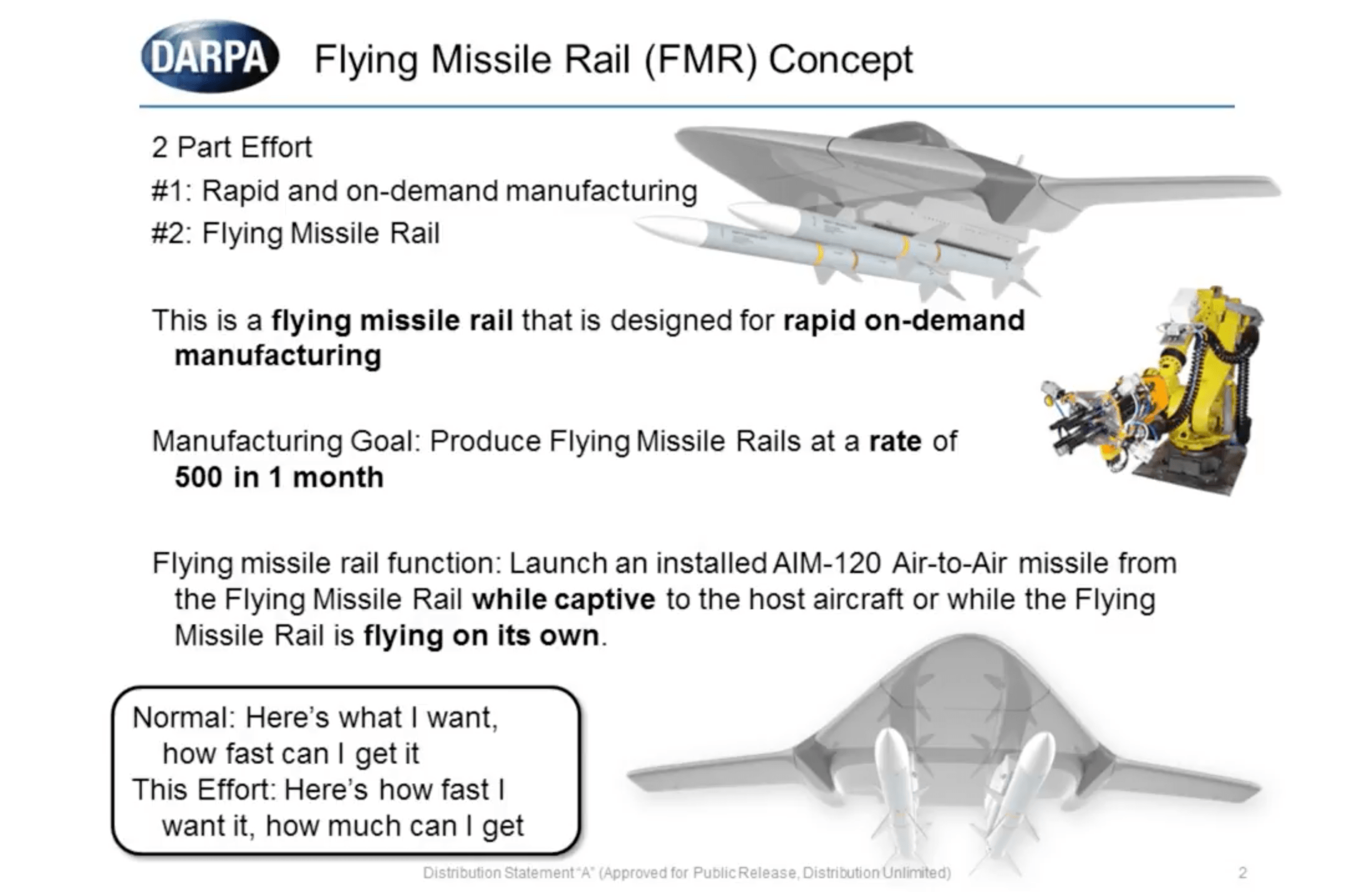
The second and maybe the most important aspect of the program is not about what the system can do as much as how it is designed and produced. The goal is to prove that the increasingly damning super long design, testing, and production cycle of modern flying combat systems can be broken. This would be done by leveraging rapid design, prototyping, and manufacturing processes with an aim of producing 500 of these systems in a single month. Obviously the strategic impact of being able to produce weapon systems or even guided munitions on such an elastic basis would be a huge breakthrough fiscally and logistically, and it would be especially impactful during a time of sustained conflict.

As Flying Missile Rail program manager Lieutenant Colonel Jones says, the concept takes the status quo question of “here’s what I want, how fast can I get it?” and changes it to “here’s how fast I want it, what can I get?”
This more agile style of procurement that leverages the latest in manufacturing techniques would allow for far more flexible production and enhanced innovation. In other words, for the dollars spent, the capabilities purchased could be better adapted to the threat faced in the near-term.
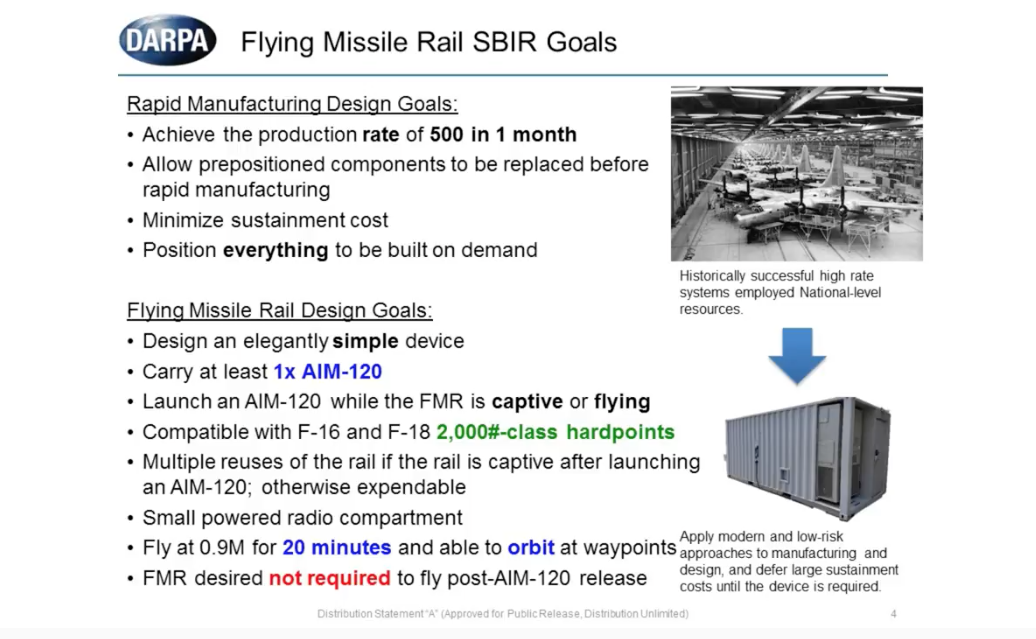
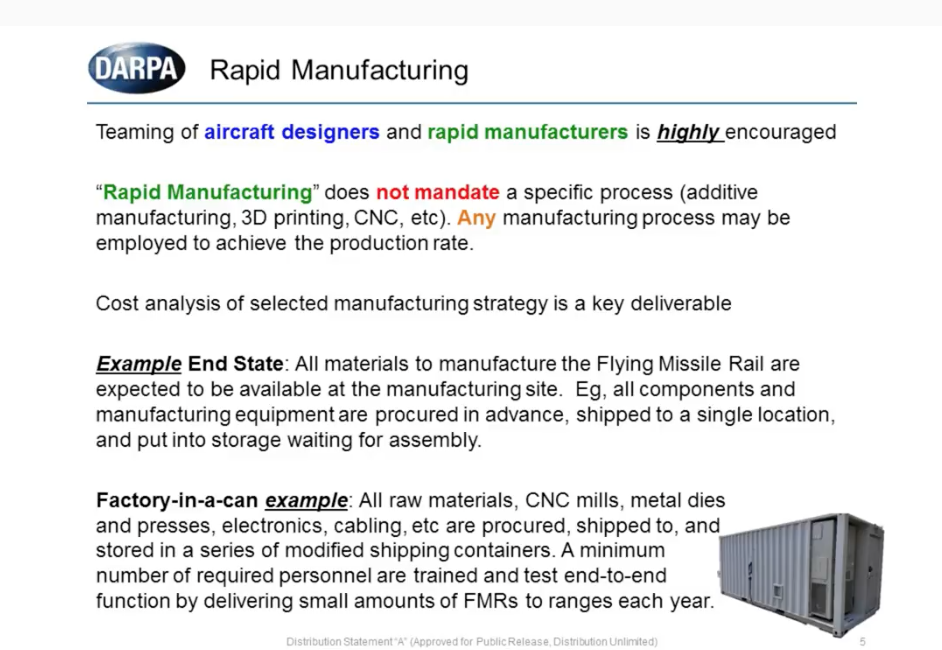
Here is the entire DARPA presentation video for the Flying Missile Rail:

The concepts behind the Flying Missile Rail program really aren’t anything new, but the fact that the Pentagon is more openly acting on their potential is, especially in terms of producing weapons with fairly complex capabilities.
At its heart, at least capabilities wise, the Flying Missile Rail isn’t a high-end semi-autonomous drone. The inherent advantages of unmanned combat aircraft systems, especially semi-autonomous and autonomous ones, are numerous compared to their manned counterparts. The War Zone detailed these advantages in our expose “The Alarming Case of the USAF’s Mysteriously Missing Unmanned Combat Air Vehicles” linked here, a few of which seem to be the underpinnings of DARPA’s Flying Missile Rail initiative:
- They are more disposable:
You don’t have to build a UCAV to fly 8,000 hours as with manned fighter aircraft, a requirement that adds significantly to an aircraft’s unit and development costs. Instead UCAVs can be designed to last a fraction of that flight time.
The reason for this is that these aircraft don’t have to fly anywhere near as much as their manned counterparts. Nobody really has to train to fly them at all. Computer simulations and modelling, a strong centralized test and development effort, and intermittent large-scale air combat exercises will be essential in proving new UCAV tactics and to certify the systems as effective, but beyond that these things can largely sit in a hangar and wait for combat. The days of putting hundreds of hours on a tactical jet airframe a year would be over. As a result, a UCAV could be designed to last a couple thousands hours of flight time or even far less.
- UCAV design and procurement can rapidly adapt to changing tactical realities:
Since they don’t have to have an 8,000 plus flight hour lifespan that will be spread over many decades, new UCAVs with enhanced design features and better low observable qualities can be bought on a regular basis. Such a concept also has the potential to greatly smooth the USAF’s notoriously disgraceful and unsustainable big-ticket weapons procurement process.
Instead of buying an entirely new fighter jet every couple of decades, the service can constantly buy far cheaper UCAV designs in tranches of ever increasing capabilities tailored to match emerging threats in near real-time. This type of procurement concept allows for a far more nimble response to changing tactical challenges, and in doing so it puts America’s potential enemies at a drastically greater disadvantage when it comes to trying to counter our own capabilities.
As UCAVs evolve, older units can be re-roled to perform non “tip of the spear” but still essential duties. These include tanking, acting as communication relays, flying data fusion centers, surveillance platforms, and acting as arsenal ships for troops on the ground in lower-threat combat environments. In other words, commanders can use their newest, most updated UCAVs for kicking down the enemy’s door while also using older systems to fulfill other critical but less risky missions where a UCAV’s persistence is still a big plus.
In the end, a UCAV, no matter how stealthy or advanced it is, is still capable of staying aloft for hours with a relatively large payload. As such, older designs will have many uses even after their “first day of war” utility is degraded by the passage of time.
- They are expendible
UCAVs can be ordered to fly into the most dangerous airspace in the world without the potential loss of aircrew being a factor, which can have huge political ramifications both abroad and at home. This also means commanders can take greater risks with greater potential rewards during conflicts and can more freely strike at the heart of the enemy’s ability to wage war.
For instance, instead of very slowly breaking down the bad guys’ area denial and anti-access capabilities from long-ranges using expensive standoff munitions, massive swarms of UCAVs can execute direct attacks on key anti-air warfare targets.
UCAV’s far lower unit cost and simpler manufacturing process, one that can make the most of large composite structures and 3D printing, also means they can be replaced more efficiently than manned aircraft. In other words, UCAVs can speed up an air campaign’s intended results compared to manned systems, while doing so at far lower risk.
With these attributes in mind, it seems like DARPA has pulled a capability set that is relevant to the increasingly popular “attritable” or “tethered” unmanned aircraft concept—where a drone acts as a combat aircraft’s slaved wingman or arsenal ship—and paired it with a very nimble procurement and manufacturing concept. In this case, the manufacturing concept is clearly more important than the military capability being tested and manufactured.
It seems that the Pentagon has become obsessed with the idea of expendable or semi-expendable and relatively cheap unmanned combat air vehicles. Undoubtedly they could have a meaningful place in future conflicts. Kratos has three of these concepts far along in development, one of which also uses the “loyal wingman” concept, and another is a semi-expendable unmanned combat air vehicle, while yet another is classified.
There are other similar programs underway as well, including far lower-end drones with swarming capabilities. But as we have pointed out multiple times before, there is zero discussion about higher-end unmanned combat air vehicles—ones that could do the job of manned assets and in many cases do that job far more efficiently and reliably and with much lower risk.
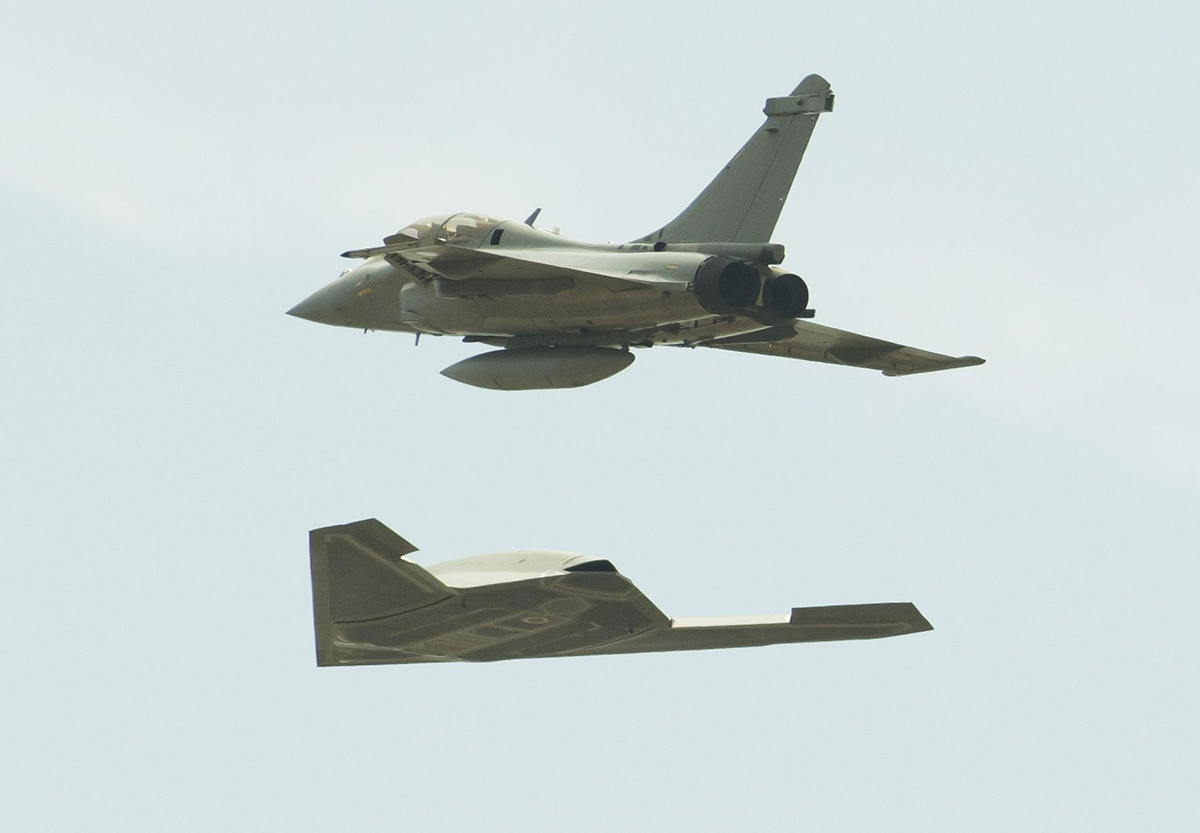
At the same time, rapid prototyping, 3D printing, and the production of large seamless composite structures have come a long way in the last decade or so, and it’s not as if the same style of manufacturing that DARPA outlaid above couldn’t be adapted today to larger and more complex unmanned air vehicle systems. In fact we know some of it already has.
Lockheed used these technologies to build its still somewhat mysterious P175 Polecat demonstrator in the early 2000s, and the shadowy RQ-170 clearly benefits from them as well. Northrop Grumman, Boeing, and General Atomics also have gained massive insight and capabilities in this space. So leveraging some of these same manufacturing techniques and concepts to build a large fleet of advanced UCAVs seems like low hanging fruit at this point for the USAF and its primary vendors and not something that has to be proven through a DARPA program.
But once again, the Air Force largely acts as if the UCAV concept doesn’t even exist. Instead it is concentrated on low-end and watered-down variations of it—at least publicly. We have speculated extensively on why this is the case, especially since the technology was proven to be game changing nearly a decade and a half ago:
“
The idea that the USAF has chosen not to procured UCAV technology in any sort of meaningful scale at all, beyond maybe some classified technology demonstrators, even a decade after the UCAV’s potential was so brilliantly demonstrated by the X-45s, sounds so troubling it borders on shameful. Yet the USAF has, to put it far too nicely, struggled greatly when it comes to integrating unmanned programs into its flyboy dominated culture.
The idea that an unmanned system could make at least some of the USAF’s manned tactical aircraft totally obsolete, even before they are built, strikes right at the heart of the USAF’s fighter pilot cabal. With this in mind, could the Air Force brass have stubbornly kept UCAVs at bay in order to protect the role of aircrews within the flying service? Especially considering that this new technology could directly threaten not only the biggest weapons program of all time, the F-35, but the last manned fighter the USAF may ever actually buy.
Given the evidence, or lack thereof, It seems possible…
…Either the USAF has a secret UCAV capability, but only in relatively tiny numbers, which handicaps many of the concept’s innate advantages, or the alternative is even worse; the USAF has not pursued the technology to any significant degree at all. Even if the better of these two possible realities is true, the veil of secrecy surrounding such a classified UCAV program has likely resulted in highly skewed procurement and strategic decisions that we may not be able to recover from for many decades.
In the end both theories result in a nation that is less well defended than it would be with a large-scale and disclosed UCAV program underway and the longer this game-changing technology remains buried or undeveloped for whatever reason, the worse off America will be.”
While DARPA should be applauded for pursuing a program like the Flying Missile Rail, it seems very strange that we are just now experimenting with the design and production concepts behind it. It almost seems as if we are now seeing concepts that have been leveraged for classified programs for some time. Then again, the scale of units the Flying Missile Rail program aims to produce as a proof of concept is likely beyond anything that has occurred in the shadows of the black budget. If that’s the case, that goal alone is well worth DARPA’s effort.
Regardless, hopefully the program will be a success and prove publicly that the old way of procuring certain air combat capabilities represents a losing strategy, and that modular and ever more complex unmanned systems produced using agile and flexible manufacturing techniques is truly the way forward.
Contact the author: Tyler@thedrive.com
